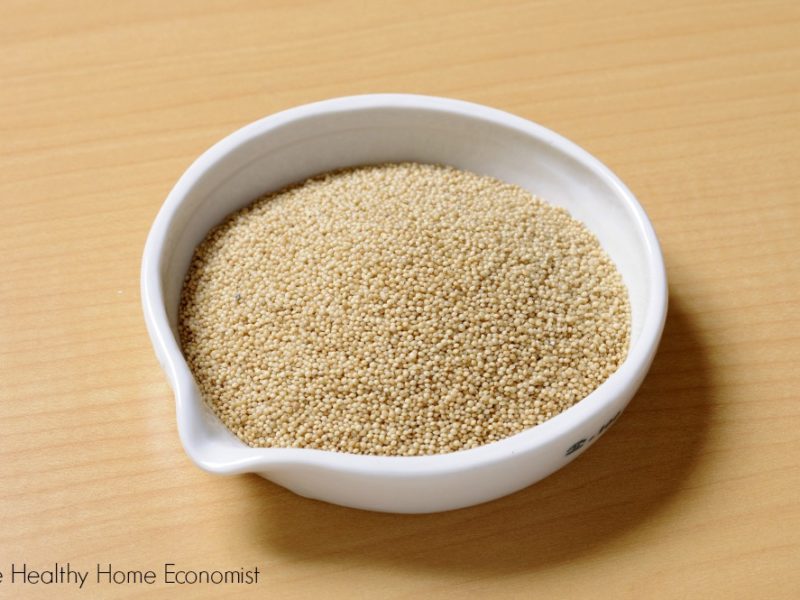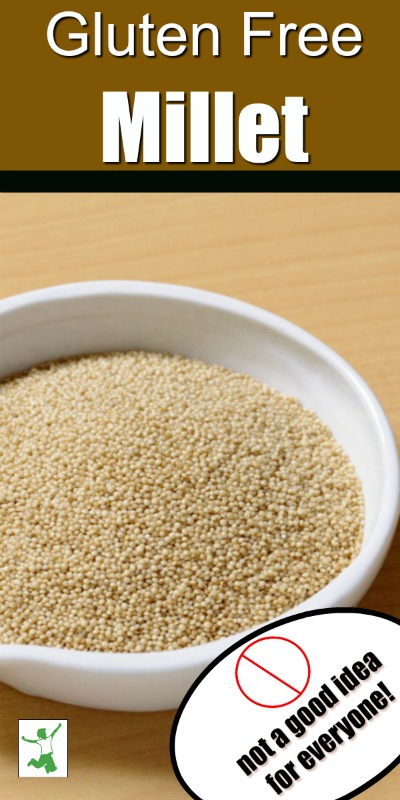Examination of why millet should optimally be eaten in moderation as a gluten-free whole grain in order to avoid disrupting hormone health.

Gluten allergies are clearly on the increase in our modern society. It seems like practically every other person I know these days has some sort of digestive issue that avoiding gluten would probably improve.
At the top of the list of gluten-containing foods is wheat. It is the indisputable, primary staple of the Western diet. Wheat is also the very foundation of the controversial USDA Food Pyramid.
Given how important bread and other wheat-based carbohydrates are to our society’s basic food requirements, it’s no wonder that folks seek a quick and easy substitute for wheat bread and wheat-based snacks when a gluten allergy or Celiac disease has been diagnosed.
Millet: Ancient Gluten-free Whole Grain
Enter millet. This ancient grain was cultivated in East Asia as far back as 10,000 years ago, according to archaeologists. Surprisingly, the cultivation of millet in prehistoric times was more prevalent than even rice, particularly in what is now China and the Korean peninsula.
Millet’s resistance to drought is perhaps the reason for its popularity in ancient times and its spread to Europe by 5000 B.C.
Despite the 5000 years cultivating this whole grain as a staple food, millet porridge is considered a traditional food in Russia as well as China. Use of millet is also widespread in Africa, like gluten-free teff, likely due to the drought-prone climate.
Millet Bread: Logical Substitute for Wheat
The protein structure of millet is quite similar to wheat. The one glaring exception is that millet is a gluten-free grain. Wheat contains copious amounts of this hard to digest plant protein.
When plain millet flour is used for baking bread (as opposed to homemade gluten-free flour or a healthy gluten-free flour mix from the store), the resulting loaf is light, white, and quite similar in texture to wheat bread. As a result, people who wish to avoid gluten tend to immediately gravitate to millet bread as the most logical and palatable substitute.
Millet bread is extremely popular in health food stores. Sami’s Bakery and Deland Bakery are two local bakeries that sell an absolute ton of millet bread to these stores around my local metro area.
I recently corresponded with a person up the East Coast of the USA who was consuming a lot of the millet/flax chips as an alternative to wheat-based snacks and had no idea of the potential health risks from consuming so much millet.
It was this discussion that led me to write this blog and warn folks about the dangers of consuming too much millet!
Potent Goitrogens
While millet does not contain gluten, it does contain goitrogens. These are substances that suppress thyroid activity and can lead to goiter. This condition involves enlargement of this very important gland which resides in the throat. Low iodine intake can also lead to goiter for those who rely on millet as a staple according to the Journal of Endocrinology and Metabolism.
Hypothyroidism is a serious and sometimes debilitating condition. It accompanies a weak or enlarged thyroid such as what occurs with goiter. Depression, difficulty losing weight, loss of hair, cold hands/feet, and fatigue are common hypothyroid symptoms. By some estimates, hypothyroidism is at epidemic proportions in Western society. (1)
Goitrogens in foods that contain them are usually reduced by cooking such as cruciferous vegetables like broccoli. However, cooking actually increases the goitrogenic effect of millet! Incidentally, the same effect occurs when fermenting soy.
Therefore, when folks begin eating large amounts of millet bread with a wholesale switch over from wheat, the thyroid suppressing effects of this simple dietary change can be profound. Injuring the thyroid can have a cascade effect on other glands as well. For example, those suffering from adrenal fatigue many times have thyroid issues as well.
Moderation is Critical
Protect your thyroid at all costs! It is a real challenge to unwind the effects of hypothyroidism once this vital gland is weakened or enlarged. Don’t take any chances with your thyroid health by consuming large amounts of millet bread or millet based snacks.
If gluten and/or wheat is a problem, then simply reduce bread consumption. Alternatively, use another grain that is both gluten-free and non-goitrogenic such as rice, oats or teff. Be sure to get quality, though, as rice is frequently high in arsenic.
Alternatively, try using grain-like gluten-free foods such as highly nutritious buckwheat, amaranth, or the starchy tuber cassava. They are excellent for baking too!
Millet bread consumption is fine in moderation if your thyroid is healthy – just don’t overdo it!
Given how difficult it is in modern society to maintain thyroid and overall glandular health, taking a chance by eating a lot of millet bread is a risky proposition indeed.
Traditional peoples did not have the constant stresses and strains on their glands like modern people do.
For example, they did not have to contend with pollution of their food, water, air and overall environment.
Therefore, we must be overprotective of our thyroid health. This includes avoiding regular consumption of foods that might impair it in any way.

Millet Alternatives That Preserve Thyroid Function
If you have thyroid issues and need alternatives to millet, here is a list of the healthiest options to consider.
- Einkorn Benefits (contains “good gluten“)
- Teff Benefits
- Yuca Root Benefits
- Arrowroot Benefits
- Wild Rice Benefits
- Farro (great if only modern wheat is the problem)








No need to worry about millets, buy a 500grams pack and keep it for a week or two (don’t use it), if you find insects in the package, then millet is good for health (you have wash and cleanup the millets and use it) else it is genetically modified crap. Make sure when you are using millets you must exercise/walk at least for a hour or two hours daily. Rice and wheat are the most dangerous food one can have also they are the most water consuming crops which in turn causes natural calamities.
It’s amazing how many people can be convinced by media that they have issues with something–gluten being the current mass hysteria. The placebo effect works both ways. Convince a person that they have problems with gluten and they will report symptoms. Not long ago it was an attack on MSG. Those same people allegedly “allergic” to MSG were okay consuming mass quantities of foods naturally containing MSG including many fresh vegetables and fruits. I’m not too surprised that you responded to a comment with an attack on fluoride in drinking water. What’s next? Should I wear a magnetic bracelet or hang a crystal around my neck for their “mystical energy”?
I was expecting to read an article about some fake products being sold as millet, or millet being sold that does not meet the quality control standards that they should. Instead I get more propaganda attempting to create a new “food fear.”
Hi do you have any scientific evidence of Goitrogen content in all types of millet if so to what extent please enlighten us !
Thanks
Sarede
Only about 5-6% of people have any problem with gluten. The current anti-gluten hysteria was originated and funded covertly by the meat industry in opposition to the FDA’s Food Pyramid that promotes whole grains, vegetables and fruits over meat.
Can sorghum be a good alternative
to millet then?
Sorghum is wonderful but can’t be used exactly like millet. Here’s an article on using the various gluten free flours and how to mix them. https://www.thehealthyhomeeconomist.com/how-to-mix-and-use-gluten-free-flour/
Is the composition of the Goitrogen in millet changed when ground up for flour or when the grain soaked? Is the thyroid affected equally regardless of whether millet is eaten as a wholegrain, soaked in preparation or simply ground and produced in bread?
If this is true there must of been a contra since it was eaten by various people of different regions who used this as a staple. THAT would be the best information to know.
Yes, good point. BUT, these ancestral peoples live in pristine environments and didn’t have their thyroids damaged by all the chemicals in their environment (such as fluoride in drinking water as one example of many).
Always when people talk about these grains, they are talking about flour. Flour is a whole different thing than whole grains. Flour of any kind is dead. It is nothing but paste. A few minutes or so after it as ground all nutritional value is gone.
Actually, freshly ground flour retains its nutrition for several days. Best to use immediately after grinding, but if you refrigerate for a few days and then use, that is fine too. Store bought flour is nutritionless even if organic.
Would millet butter instead of dairy butter, used on a daily basis be of a concern?
Is milet good for infants during weaning?
I would recommend no grains for infants during weaning! Here is a post on feeding baby properly. https://www.thehealthyhomeeconomist.com/right-way-to-feed-babies/